
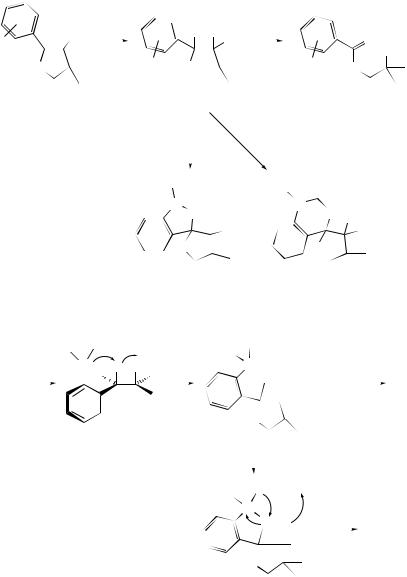
5 Oxidation and Reduction |
|
|
|
|
|
|
|
|
|
|
|
|
|
|
|
|
|
|
|
|
237 |
||||||||||
|
|
|
|
|
Bu |
t |
1O2 |
|
|
|
|
|
|
|
O |
|
|
O |
|
∆ |
|
|
|
|
|
|
|
|
|
|
|
|
|
|
|
|
|
|
|
|
|
|
|
|
|
|
|
|
|
|
|
|
|||||||||||
X |
|
|
|
|
|
|
|
|
|
|
|
|
|
|
|
|
|
But |
|
|
|
|
|
|
|
|
|
|
O |
||
|
|
|
|
|
|
|
|
|
|
X |
|
|
O |
|
|
|
|
|
X |
|
|
|
COBut |
||||||||
|
|
O |
|
|
|
|
|
|
|
|
|
|
|
||||||||||||||||||
|
|
|
|
|
|
|
|
|
|
|
|
|
|
O |
|||||||||||||||||
|
|
|
|
|
|
|
|
|
|
|
|
|
|
|
|
|
|
||||||||||||||
|
|
|
|
|
|
|
|
|
|
|
(15) |
|
|
|
|
|
|
X = o-NH2, p-NH2, |
|||||||||||||
|
|
|
|
|
|
|
|
|
X = o-NHMe |
|
|
|
|
X = o-NMe2 |
|
|
|
|
p-NHMe, p-NMe2 |
||||||||||||
|
|
|
|
|
|
|
|
|
|
|
|
|
|
|
|
|
|||||||||||||||
|
|
|
|
|
|
|
|
|
|
|
|
|
|
|
|
|
|
|
|
|
|||||||||||
|
|
|
|
|
|
|
|
|
|
|
|
|
|
|
|
|
|
|
|
|
|
|
|
||||||||
|
|
|
|
|
|
|
|
|
|
|
|
|
|
|
|
|
|
|
|
|
|
|
|
|
|
|
|
|
|
||
|
|
|
|
|
|
|
|
|
|
|
Me |
|
Me |
|
|
|
|
|
|
|
|
||||||||||
|
|
|
|
|
|
|
|
|
|
|
|
|
|
|
|
|
|
|
|
|
|
|
|
|
|
|
|
|
|||
|
|
|
|
|
|
|
|
|
|
|
|
|
N O OH |
|
|
|
|
N |
|
O OH |
|||||||||||
|
|
|
|
|
|
|
|
|
|
|
|
|
|
|
|
|
|
|
But |
|
|
|
|
|
|
|
|
|
|
But |
|
|
|
|
|
|
|
|
|
|
|
|
|
|
O |
|
|
|
|
|
|
O |
|
|
|
|
|||||||
|
|
|
|
|
|
|
|
|
|
|
|
|
|
|
|
|
|
|
|
|
|||||||||||
|
|
|
|
|
|
|
|
|
|
|
(13) |
|
|
|
|
|
|
|
|
(14) |
|
|
|||||||||
|
|
|
|
|
|
|
|
|
|
|
|
|
SCHEME 6 |
|
|
|
|
|
|
|
|
|
|
|
|
||||||
|
|
|
|
|
|
|
|
|
|
|
|
|
|
|
|
|
|
|
R2 |
R1 |
|
|
|
|
|
|
|
|
|
|
|
|
|
|
|
|
|
• |
|
|
|
|
|
|
|
|
|
|
|
|
|
+ |
|
|
|
|
|
|
|
|
|
|
|
|
|
|
|
|
|
|
|
|
|
|
|
|
|
|
|
|
|
|
N |
|
|
|
|
|
|
|
|
|
|
||
|
|
|
|
|
N • |
O |
|
O |
|
|
|
|
|
|
|
|
|
O |
O− |
|
|
R1 |
= H, R2 = Me |
||||||||
(15) |
|
|
|
|
|
|
|
|
|
|
|
|
|
|
|
|
|
|
|
|
|
|
|
|
|
|
(13) |
||||
|
|
|
|
|
|
|
|
|
|
|
|
|
|
|
|
|
|
O |
But |
|
|
|
|||||||||
|
|
|
|
|
|
|
|
|
|
|
|
|
|
|
|
|
|
|
|
|
|
|
|
|
|
||||||
|
|
|
|
|
|
|
|
|
|
|
|
|
|
|
|
|
|
|
|
|
|
|
|
|
|
|
|
|
|
||
|
X = o-NHMe, o-NMe2 |
|
|
|
|
|
|
|
|
|
|
|
|
|
R1 = R2 = Me |
|
|
|
|
||||||||||||
|
|
|
|
|
|
|
|
|
|
|
|
|
|
|
|
|
|
||||||||||||||
|
|
|
|
|
|
|
|
|
|
|
|
|
|
|
|
|
|
|
|
|
|
|
|
|
|||||||
|
|
|
|
|
|
|
|
|
|
|
|
|
|
|
|
|
|
|
|
|
|
|
|
|
|
|
|
|
|
||
|
|
|
|
|
|
|
|
|
|
|
|
|
|
|
|
|
|
|
|
|
|
|
|
|
|
|
|
|
|
||
|
|
|
|
|
|
|
|
|
|
|
|
|
|
|
|
|
|
|
Me |
+ |
CH2 |
|
H |
|
|
|
|
|
|||
|
|
|
|
|
|
|
|
|
|
|
|
|
|
|
|
|
|
|
|
|
|
|
|
||||||||
|
|
|
|
|
|
|
|
|
|
|
|
|
|
|
|
|
|
|
|
|
|
|
|
|
|
|
|
|
|
||
|
|
|
|
|
|
|
|
|
|
|
|
|
|
|
|
|
|
|
|
N |
O |
|
|
|
|
|
|
|
|
|
|
|
|
|
|
|
|
|
|
|
|
|
|
|
|
|
|
|
|
|
|
|
O− |
|
|
|
|
|
|
(14) |
|||
|
|
|
|
|
|
|
|
|
|
|
|
|
|
|
|
|
|
|
|
|
|
|
|
|
|
|
|||||
|
|
|
|
|
|
|
|
|
|
|
|
|
|
|
|
|
|
|
|
|
|
|
But |
|
|
|
|
|
|||
|
|
|
|
|
|
|
|
|
|
|
|
|
|
|
|
|
|
|
|
O |
|
|
|
|
|
|
|
|
|
|
|
|
|
|
|
|
|
|
|
|
|
|
|
|
|
|
|
|
|
|
|
|
|
|
|
|
|
|
|
|
|
|
|
SCHEME 7
the corresponding TBS ethers strongly suggest that the epoxidation by Oxone was facilitated by the hydroxyl group in the substrate perhaps due to enhanced intramolecular epoxidation through hydrogen bonding or enhancing the aqueous solubility of the substrate.
Denmark and Wu have suggested188 discrepancies in previous [18O]dioxirane labelling experiments189,190 and disclosed their results as shown in Scheme 8; 34% incorporation
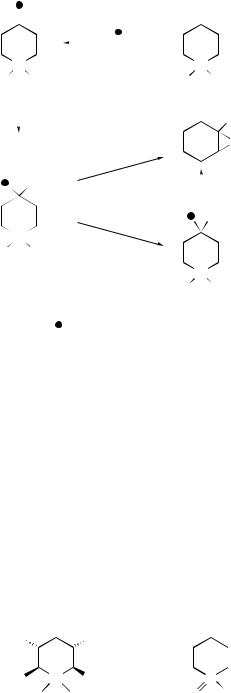
238 |
|
|
|
|
|
Organic Reaction Mechanisms 1998 |
||||
|
|
|
|
|
|
O |
|
|||
|
|
|
|
|
H2 |
|
|
|
|
|
|
|
|
|
|
|
|
|
|
|
|
|
|
|
|
|
|
|
|
|
|
|
+ |
|
X− |
slow exchange |
+ |
|
X− |
||||
N |
|
|
N |
|||||||
Me |
Me |
|
Me |
Me |
||||||
|
KHSO5 |
|
+ |
Ph |
||||||
|
|
|||||||||
|
|
|
|
|
|
|||||
|
|
|
|
|
|
|
|
|
|
|
|
|
OSO3−K+ |
|
|
|
|
|
O |
||
|
|
PCH |
|
|
|
|
|
|||
H |
|
|
|
path a |
|
|
|
|
|
|
O |
|
|
|
PCH |
||||||
|
|
|
|
|
|
|
|
|
||
+ |
|
X− |
path b |
|
|
|
|
O |
||
|
|
|
|
|
||||||
|
|
|
|
|
||||||
|
|
|
|
|
|
|||||
|
|
|
|
|
|
|
||||
N |
|
−KHSO4 |
|
|
|
|
|
|||
Me |
Me |
|
|
|
|
|
||||
|
+ |
|
|
|||||||
criegee |
|
|
X− |
|||||||
|
N |
|||||||||
intermediate |
|
Me |
Me |
|||||||
|
|
|
|
|
|
|||||
PCH = 1-phenylcyclohexene
= 18O (90% 18O)
X = TfO
SCHEME 8
of 18O into epoxide was observed. The disparity between 34% and the theoretically expected 43% (50% of the 86% present in the labelled water used) was attributed to the slow exchange of ketone O in H218O. This was confirmed by increasing the number of ketone equivalents to 5, which gave increased (39%) incorporation. They suggest that the problem with previous ketone systems was that there was no mechanistically significant, ketone-catalysed pathway in those cases owing to the insolubility of the ketone in the aqueous phase, and that this explains the lack of 18O incorporation observed in those previous cases.
By exploiting electrostatic field effects (unfavourable through-space charge–dipole repulsion) to increase the nucleophilic susceptibility of cyclohexanones, more efficient catalysts (16) and (17) for epoxidation through in situ dioxirane formation have been designed.191
|
O |
|
O |
|||
Me |
|
|
Me |
|
|
|
+ |
−OTf |
|||||
|
|
|||||
|
|
S |
||||
Ph |
N |
Ph |
||||
O O
(16) |
(17) |
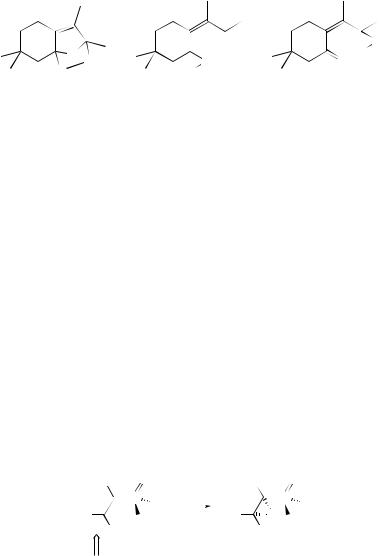
5 Oxidation and Reduction |
239 |
The thiophene endoperoxide (18) is a powerful episulfidation reagent.192 The stereospecific transformation of cis- or trans-cyclooctene suggests a concerted process. Firstorder consumption kinetics have now shown that (18) is not itself the active S-transfer reagent: two such intermediates are proposed, possibly oxathiiranes such as (19) or (20), based on similarities in the trends for epoxidations of the same substrate by DMDO.193
O |
O |
O |
||||
|
|
|
|
|
|
O |
|
|
|
|
|
|
|
|
|
|
|
|
|
|
|
S O |
|
O |
|
S |
|
|
|
S |
|
O |
||
|
O |
|
O |
|
|
|
(18) |
(19) |
|
(20) |
|||
Pinene hydroperoxide (PHP) when compared with t -butyl hydroperoxide has been proposed as an excellent mechanistic probe in metal-catalysed oxidations.194 If intermolecular oxygen transfer from a peroxometal species to the substrate is rate limiting, the bulky PHP is unreactive, but for reaction of an oxometal species as the rate-limiting step, little or no difference is observed and only small differences in reactivity are observed when re-oxidation of the catalyst by ROOH to an active oxometal species is the rate-limiting step.
t -Butyl and cumene hydroperoxide allow hydroxylation of nitroarenes by vicarious nucleophilic substitution (nucleophilic addition of alkyl hydroperoxide anion followed by base-induced E2 β-elimination of ROH).195 Stereoselective nucleophilic epoxidation of simple vinyl and dienyl sulfoxides with NaOOBut or KOOBut has been rationalized by initial nucleophilic addition to the α-face of the reactive conformation shown in Scheme 9 followed by epoxide ring closure.196 It is likely that steric hindrance by the bulky tolyl group is a key factor. Interestingly, the diastereoselectivity of the epoxidation of (1E)-2-sulfinyl dienes can be altered by a simple change in the metal cation from Li+ to Na+.
Ab initio calculations of the transition-state energies in the epoxidation of alkenes by hydrogen peroxide catalysed by titanosilicates have been carried out.197 They indicate a markedly lower energy barrier for attack of the alkene by the oxygen atom of the titanium(IV) hydroperoxide intermediate that is closer to the metal centre.
R2 |
O |
|
|
R2 |
|
O |
S |
• |
|
|
|
|
S • |
R3 |
• |
|
|
R3 |
O |
• |
|
|
|||||
|
|
|
Tol |
|||
Tol |
|
|
R1 |
|||
R1 |
|
|
|
|
||
a-attack |
|
|
|
a-oxirane |
||
|
|
SCHEME 9 |
|
|
||
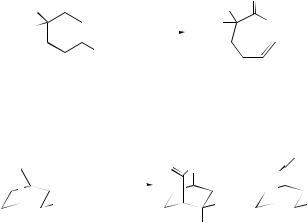
240 |
Organic Reaction Mechanisms 1998 |
The Baeyer–Villiger (BV) oxidation of ketones to esters involves the migration of one of the groups flanking the carbonyl to the adjacent electron-deficient oxygen atom. For unsymmetrical ketones, the migratory aptitudes of the groups is determined by their relative abilities to support the developing positive charge in the transition state. It is well known that substituents of Group 14 (Si, Ge, and Sn) are able to stabilize positive charge at the β-position, and that a β-silicon atom does, indeed, enhance the migratory aptitude of groups in the BV reaction. A study of the BV reaction of β-stannyl cyclohexanones has now revealed that a β-trimethylstannyl substituent raises the migratory ability of a primary carbon to above that of a tertiary carbon (in the absence of other activation); thus, compounds (21)–(23) gave the acyclic alkene acids (24)–(26), either via the corresponding lactones or possibly a concerted breakdown of the initially formed tetrahedral intermediate.198 A separate study on the BV oxidation of norbornan-7-ones has revealed a remarkable effect of distal 2- endo-substituents on migratory ability and hence on the regioselectivity of the reaction (Scheme 10).199 Electron-withdrawing substituents at the C(2)-endo position reduce
|
|
O |
|
R1 |
O |
|
R |
1 |
|
|
|
||
R |
2 |
|
|
RCO3H |
R2 |
OH |
|
|
|
|
|
|
|
SnMe3
(21) R1 = R2 = H (22) R1 = H, R2 = Me (23) R1 = R2 = Me
(24) R1 = R2 = H (25) R1 = H, R2 = Me (26) R1 = R2 = Me
O |
|
O |
||||
|
|
|
|
O |
O |
|
|
|
|||||
|
|
|
Baeyer−Villiger |
|
+ |
O |
|
|
|
oxidation |
|
||
|
|
|
H |
H |
||
|
H |
|||||
|
R |
R |
R |
|||
|
|
|
|
|
A |
B |
|
|
|
|
|
||
|
|
R |
A:B product ratio |
|
||
|
|
|
|
|
||
|
|
CN |
100:0 |
|
||
|
|
CO2Me |
>90:10 |
|
||
|
|
OMe |
77:23 |
|
||
|
|
Ph |
51:49 |
|
||
|
|
C6H4OMe-p |
39:61 |
|
||
|
|
OC6H4F-p |
52:48 |
|
||
|
|
C6H4NO2-o |
70:30 |
|
||
|
|
C6H4NO2-p |
75:25 |
|
||
SCHEME 10
5 Oxidation and Reduction |
241 |
the propensity of the C(1)−C(7) bond to migrate compared with the C(4)−C(7); for R = CN, the effect is so large that migration of the latter occurs exclusively to give a single product. Thus, the strong inductive effect of such substituents is relayed to the C(1)−C(7) bond through the C(1)−C(2) bond. On the other hand, an aryl group at C(2) incorporating an electron-donating methoxy substituent leads to a reversal in regioselectivity. For a simple phenyl group (R = Ph), the inductive electron withdrawal is probably counterbalanced by through-space π -donation into the C(1)−C(2), leading to the absence of any migratory preference in this case.
Some evidence for stereoelectronic effects in peroxide rearrangements, such as Criegee and Baeyer–Villiger rearrangements, has been determined.200 Certain hydroperoxides display highly unusual reactivity patterns under conditions for effecting Criegee rearrangement. The bond conformation revealed in corresponding crystal structures suggests that the bond antiperiplanar to the dissociating peroxide bond is always and exclusively the bond that migrates, even when electronically disfavoured from doing so.
Fenton-type reagents [H2O2 or t -butyl hydroperoxide (TBHP) with Fe/Co/Cu catalysts] are of increasing interest as more benign, catalytic alternatives to the use of stoichiometric chromium-based oxidants in benzylic and allylic oxidations. In a study employing TBHP and copper salts under phase-transfer conditions, π -activated methylene groups are oxidized to t -butyl peroxides, e.g. 1,2,3,4-tetrahydronaphthalene (tetralin) is oxidized to 1-t -butylperoxytetralin.201 The reaction proceeds according to a classic Kochi free-radical mechanism involving t -BuO radicals and Cu(II)−OOBu-t . Secondary allylic and benzylic alcohols are oxidized under the same conditions to ketones. In this case, however, observations including a very large kinetic isotope effect (kH/ kD = 12.9) for PhCH(OH)Me compared with PhCD(OH)Me indicate that the rate-determining step involves breakage of the benzylic C−H bond and that reaction proceeds via a heterolytic mechanism, the copper catalyst being transformed to Cu(OH)Cl which enters the organic phase. The co-existence of two distinct reaction pathways in the same medium has been attributed to H-bonding of the alcohol substrate with the TBHP oxidant, which lessens the free-radical, peroxidic hydrogen abstraction by the t -butyloxy radical. A review on recent progress in the study of oxidation with hydrogen peroxide in organic synthesis has appeared.202
Photo-Oxygenation, Singlet Oxygen, and Superoxide
A type I one-electron photo-oxidation of methionine–methionine-containing peptides by triplet carboxybenzophenone in air-saturated aqueous solution has been reported; the S+• radical cation that is formed then reacts with the other Met-S to form an S−S three-electron complex which reacts with superoxide radical anion before hydrolysis to Met(=O)−Met(=O) bis-sulfoxide.203 Alternatively, cyclization of the N -terminal NH2 on to the S can occur to give a three-electron S−N complex which can react with superoxide radical anion to give a cyclic sulfonium intermediate.
Whilst reactions of α, β-unsaturated carbonyl compounds with 1O2 have been the subject of a number of studies, the corresponding reactions of their enolic tautomers have received little attention. Reaction of the β-hydroxy-α, β-unsaturated ketones
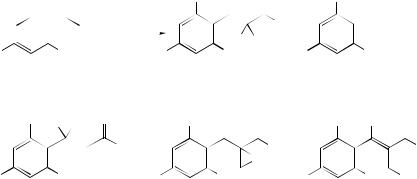
242 |
|
|
|
|
|
|
|
|
|
|
|
|
Organic Reaction Mechanisms 1998 |
|||||||
R |
OH O |
|
|
R |
|
|
O |
|
O |
R |
O |
O |
||||||||
|
|
|
|
|
R1 |
1O2 |
|
|
|
|
|
|
|
R1 |
+ |
|
|
|
R1 |
|
|
|
|
|
|
|
|
|
|
|
|
|
|
|
|
||||||
|
|
|
|
|
|
|
|
|
|
|
|
|
|
|||||||
|
|
Me |
|
|
|
|
|
|
Me OOH |
|
|
|
|
|||||||
R |
R |
|
|
|
|
R |
R |
|
|
|||||||||||
R |
|
|
|
R |
|
|
|
|
|
|||||||||||
R = Pri or Me |
|
|
|
(27) |
|
|
|
|
(29) |
|
|
|||||||||
R1 = Pri, Et or Me |
|
|
|
|
|
|
|
|
|
|
|
|
|
|
|
|||||
R HO |
OOH O |
|
|
R |
|
O |
O |
R |
OH |
O |
||||||||||
|
|
|
|
|
R1 |
+ |
|
|
|
|
|
|
|
|
R1 |
+ |
|
|
|
R1 |
|
|
|
|
|
|
|
|
|
|
|
|
|
|
|
|
|||||
|
|
|
|
|
|
|
|
|
|
|
|
O |
|
|
|
|
||||
R |
R |
R |
|
|
R |
|
|
|
R |
R |
OR2 |
|||||||||
(28) |
|
|
|
|
|
|
(30) |
|
|
|
|
|
(31) |
|
|
|||||
|
|
|
|
|
|
|
|
|
|
|
|
|
|
|
|
R2 = Me (in MeOH) |
||||
|
|
|
|
|
|
|
|
|
|
|
|
|
|
|
|
R2 = Et (in EtOH) |
||||
SCHEME 11
in Scheme 11 led to the products shown.204 The photo-oxidation probably involves an ene reaction with 1O2, in which the oxygen abstracts hydrogen either from the enolic hydroxy group, to generate (27), or from the 2-methyl group, leading to (28). Decomposition of (28) by loss of hydrogen peroxide leads to the major enedione product (29), which can subsequently react with the H2O2 liberated to give (30). In alcoholic solvents, compounds of the form (31) predominate, and are probably formed by conjugate addition of the alcohol on the enedione. Epoxidation to give (30) is reduced by bulky substituents in the ring ortho positions and at the terminal carbonyl, and favoured when all substituents are methyl. It has been shown that the phenyl ring of styrene substrates can dictate the syn/anti stereochemistry in ene reactions with singlet oxygen and triazolinediones, perhaps through a favourable interaction of the enophile with the phenyl ring (Scheme 12).205
Ab initio calculations of the transition structures for the Schenck reaction of singlet oxygen suggest that Me substitution makes the transition structure earlier and more stable and that the transition-state geometry is sensitive to the position of Me substituents.206
Tyrosine hydroxylase catalyses the formation of DOPA from tyrosine using molecular oxygen and tetrahydropterin as a co-factor. There are no primary deuterium or solvent kinetic isotope effects; however an 18O isotope effect of 1.0175 (±0.0019) measured through the isolation of remaining O2 has been recorded.207 The results support a rate-limiting reductive activation of molecular oxygen via a one-electron transfer from the tetrahydropterin to from superoxide anion as a key reactive intermediate. Ab initio calculations suggest that an S-hydroperoxysulfonium ylid is an important intermediate in the 1O2 oxidation of sulfides.208 This ylid intermediate can rearrange to either an α-hydroperoxide or to a protonated sulfone ylid and then to the sulfone product. Similar results were obtained from an almost parallel study.209
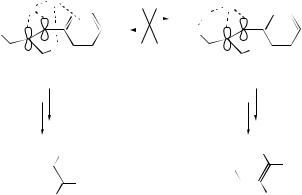
5 Oxidation and Reduction |
|
|
|
|
|
|
|
|
|
|
243 |
||||||
|
|
d− |
|
|
|
‡ |
|
|
|
|
|
|
|
|
|
|
‡ |
|
|
|
|
|
|
|
|
|
|
d+ |
|||||||
|
|
d+ O |
d+ |
|
|
|
|
|
|
d− |
|
||||||
|
|
|
|
|
|
|
|
O |
|
||||||||
|
|
O |
|
|
|
|
|
|
|
|
|
O |
|
||||
|
D |
|
|
|
|
|
|
|
|
D |
|
|
|
|
|
||
|
|
|
|
|
|
|
|
|
|
|
|
|
|||||
|
|
H |
|
|
|
|
|
|
|
|
|
|
H |
|
|
|
|
|
|
|
|
|
|
|
|
|
|
|
|||||||
|
|
|
|
|
|
|
|
|
|
|
|
|
|
|
|
||
|
|
transition state 1 |
|
|
|
|
|
|
transition state 2 |
||||||||
HOO |
CD3 |
|
D |
|
|
DOO |
D |
Ph |
H |
|
|
|
H |
Ph |
CH3 |
syn-adduct (major) |
anti-adduct (minor) |
||
SCHEME 12
Atomic Oxygen, Triplet Oxygen, and Autoxidation
Under oxidative conditions, p-benzoquinone is primarily consumed via thermal dissociation at lower temperatures, whereas hydrogen-abstraction reactions with the O/H radical pool lead to OC6H3O and C6H3O at higher temperatures.210 This shift occurs at lower temperatures with a higher oxygen concentration. The oxidation of isobutene in O2 was studied in a continuous-flow stirred-tank reactor and shock tube.211 Comparison of the partial-pressure profiles of various products of the reaction fit reasonably well with theoretical data obtained with CHEMKIN II software. The kinetics of the oxidation of dimethyl ether in a jet-stirred reactor and shock tube have been studied212 and product and intermediate distributions compare well with calculations using a numerical model consisting of 336 reactions. The major products detected were CO, CO2, H2, H2CO, and CH4. The thermal gas-phase oxidation of tetrachloroethene by molecular oxygen in the presence of trifluoromethyl hypofluorite (CF3OF) has been studied and a detailed mechanism was presented.213 The application of a system of computer-aided design of kinetic models of oxidation and combustion to previously obtained results for the oxidation of n-octane and n-decane has been performed with satisfactory fitting of the conversion and distribution of products formed.214 The oxidation of methanol over a wide range of temperature and pressure is sensitive to the kinetics of the hydroperoxyl radical through a branching mechanism involving hydrogen peroxide (H2O2 → 2OH) at low temperature and a terminating mechanism (H2O2 → H2O + O2) at high temperature.215
In order to model the oxygenation of vitamin K in its hydroquinone form, a naphthohydroquinone derivative with a 1-hydroxy group and 4-ethyl ether was prepared and its alkoxide subjected to oxidation with molecular oxygen.216 Products consistent with two possible mechanisms were isolated, the epoxy-quinone which must derive from a peroxy anion intermediate at the 4-position, and a 2-hydroxy product which

244 |
Organic Reaction Mechanisms 1998 |
could arise from a 2-peroxy anion intermediate. The liquid-phase oxidation of 1- and 2-isopropenylnaphthalene with pure oxygen in PhCl solution in the presence of cumene and cumene hydroperoxide at 75–125 ◦C has been investigated.217
The Cope rearrangement of the highly strained diene (32) (Scheme 13) is shown to proceed by a non-concerted mechanism involving the diradical (33), which may be trapped by oxygen to give the peroxide (34). A full kinetic study confirms the intermediacy of the diradical.218
|
|
|
|
|
|
|
|
|
|
|
O2 |
|
|
|
|
|
|
|
|
• |
|
|
|
|
O |
|
|
|
|
|
|
|
|
|
|
|||
|
|
|
|
|
|
|
|
|
|
|
||
|
|
|
|
|
|
|
• |
|
|
|
||
|
|
|
|
|
|
|
|
|
|
|
||
|
|
|
|
|
|
|
|
|
|
|
|
O |
(32) |
|
(33) |
|
(34) |
||||||||
SCHEME 13
The use of O(3P) atoms produced by microwave irradiation of He–O2 mixtures has shown that alkenes react with atomic oxygen in solution or neat to give predominantly epoxides.219 Unlike reactions in the gas phase, at low temperature these produce useful product yields and distributions. Similar yields suggest that epoxide formation and 1,2-H/1,2-C shifts/ring contractions compete.
Other Oxidations
The stereoselectivity of enzymatic primary carbon hydroxylation has been reviewed.220 The phthalimide N -oxyl radical (PINO), which may be formed from N -hydroxyphthal- imide (NHPI), has been shown to catalyse the oxygenation of alkynes to α, β-acetylenic ketones with dioxygen under mild conditions, in the presence of a transition metal catalyst, e.g. Co(acac)2.221 The subsequent introduction of oxygen into the prop-2- ynylic C−H bond is presumed to occur by a free-radical process involving hydrogenatom abstraction at the energetically favourable prop-2-ynylic position. EPR analysis suggests that, in order for the PINO radical to be formed from NHPI, the alkynyl substrate must be present, in addition to O2. The mechanism of the synergistic oxidation of cyclohexane with H2S and O2 has been investigated by addition of PhSeSePh; the results rule out the involvement of carbon and oxygen radicals.222 The pyrolysis and oxidation of formaldehyde at high temperatures have been investigated by monitoring the progress of the reaction by laser absorption of CO molecules.223 A detailed kinetic analysis led to a new reaction model giving good agreement with the experimental data.
Human type II inosine monophosphate dehydrogenase catalyses NAD-dependent conversion of inosine monophosphate (IMP) into xanthosine monophosphate (XMP); measurements of the primary kinetic isotope effect using [2H]IMP suggest that both substrates (IMP and NAD) can dissociate from the enzyme–substrate complex; therefore, the kinetic mechanism is not ordered. NMR studies indicate hydride transfer to the B or pro-S face of the nicotinamide ring of NAD, while kinetic studies suggest
5 Oxidation and Reduction |
245 |
that this is a kinetically significant step, although the rate-limiting step occurs at a later stage in the mechanism.224
The one-electron oxidation of N -benzylphenothiazine by nitric acid occurs in the presence of β-cyclodextrin, which stabilizes the radical cation by incorporation into its cavity. The reaction is inhibited by adamantane, which preferentially occupies the cavity.225 Novel Pummerer-type rearrangements of p-sulfinylphenyl derivatives, yielding p-quinones and protected dihydroquinones, and highly enantioselective Pummerertype rearrangements of chiral, non-racemic sulfoxides have been reviewed.226 A comprehensive study has demonstrated that the redox potential for 7- and 8-substituted flavins is linearly correlated with Hammett σ values.227 DFT calculations in [3.3.n]propellanes highlight low ionization potentials that favour SET oxidative cleavage of the strained central C−C bond rather than direct C−H or C−C bond attack.228 Oxidations and reductions in water have been reviewed.229
Reduction by Complex Metal Hydrides
The applications of sodium acyloxyborohydrides, formed from sodium borohydrides in carboxylic acid media, are reviewed.230 Useful reviews of the stereoselective reduction of endocyclic C=N compounds231 and of the enantioselective reduction of ketones have appeared.232
A nice analysis of non-linear effects in Rh–chiral diamine-catalysed transfer hydrogenation has been performed that reinforces the need to consider the kinetics of all of the steps in reaction manifolds (e.g. reversible formation of diastereomeric precursors and their subsequent interaction with achiral reactants).233
Some further examples of the reduction of adamantanones have highlighted that increasing the positive dipole on the C=O using Lewis acids, or placing charged substituents at C(5) within the adamantyl framework, enhances face selectivities in borohydride and aluminium hydride reductions due to Cieplak effects.234
Other Reductions
The reduction of (2,3)-α- and (2,3)-β-methylenepenam β-sulfoxides to the corresponding sulfides using potassium iodide and trifluoroacetic anhydride (TFAA) is found to be much faster than for bicyclic β-lactam β-sulfoxides.235 In the proposed mechanism, initial attack of the sulfoxide oxygen on TFAA is followed by rate-limiting, nucleophilic displacement of trifluoroacetate by iodide ion; nucleophilic attack of iodide on the iodine atom then yields the sulfide and iodine. The rate enhancement is accounted for by the stabilization of the transition state in the rate-limiting step by interaction of the p-like orbital of sulfur and the cyclopropane σ orbital.
The results of kinetic studies on the reaction between iodide and N -chloro compounds support a mechanism in which the rate-determining transfer of Cl+ from the N -chloramine to iodide gives an ICl intermediate which rapidly reacts with excess iodide to give triiodide ions.236
The mechanisms of electrochemical reduction of 9-chloroanthracene, 3-nitrobenzyl chloride, and 3-chloroacetophenone have been investigated by means of cyclic voltammetry.237 The effect of different aprotic solvents was studied and, in the case of
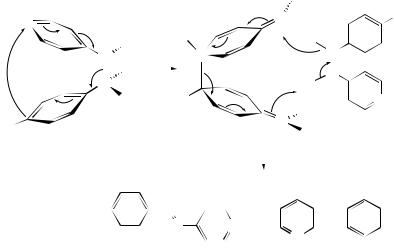
246 |
Organic Reaction Mechanisms 1998 |
9-chloroanthracene and 3-nitrobenzyl chloride, the rate of the reaction was found to depend on the electrophilic properties of the solvent as defined by Gutmann acceptor and donor numbers, respectively; 3-chloroacetophenone showed no linear dependence on solvent properties.
Atomic charges, effective charges at reacting centres, and HOMO and LUMO energies have been calculated for nitrobenzene, nitrosobenzene, N -phenylhydrazine, diphenyldiazine, N ,N -diphenyldiazine-N -oxide, and N ,N -diphenylhydrazine, compared with kinetic data for the hydrogenation of these compounds, and used to propose a mechanism for the hydrogenation of nitrobenzene.238
Reduction of N -arylmaleimides with sodium dithionate gives monomeric and dimeric products; a mechanism has been proposed.239
The kinetics of the reduction of 2,6-dichlorophenolindolphenol (DCPI), a common dye used for analysing ascorbic acid, by Fe2+ and oxalate have been studied and indicate the rapid formation of an intermediate complex of Fe2+ and C2O42−, predominantly FeC2O4, prior to the reduction of DCPI.240
Disproportionations
The disproportionation reactions of 4-(4-chlorophenylazo)pyridine and 4-(4-chlorophen- ylhydrazo)pyridine in acidic media have been studied. The hydrazo compound disproportionates to give 1 mol of the azo compound (35) and 1 mol each of the reduced products 4-chloroaniline and 4-aminopyridine. The azo compound also undergoes a slower hydroxylation reaction giving a variety of products. A proposed mechanism for the disproportionation of 4-(4-chlorophenylhydrazo)pyridine consistent with observed first-order kinetics involves a rate-determining electrocyclic rearrangement of the diprotonated species (Scheme 14).241
|
|
|
|
|
|
|
|
|
|
H |
|
|
|
|
|
|
+ |
|
|
|
|
|
|
|
|
|
N |
|
|
|
|
|
Cl |
HN |
|
|
|
|
|
|
|
|
|
|
|
|||||
|
|
H |
|
H |
|
|
|
|
|
H |
|
|
|
|
||
|
|
|
|
+ N |
|
N |
||||||||||
|
|
|
|
|
|
|
||||||||||
N |
slow |
|
|
|
||||||||||||
|
|
|
|
|
|
|
||||||||||
|
|
H |
|
|
|
|
|
|
|
|
|
|
|
|
|
|
|
|
|
|
|
|
|
|
|
|
N |
||||||
|
|
|
|
|
|
|
|
|
|
|||||||
N |
|
|
|
|
|
|
|
H |
|
|
+ |
|||||
|
|
|
|
|
|
|
|
|
||||||||
+ |
H |
|
Cl |
|
|
|
|
|
|
|
|
|||||
|
|
|
|
|
|
|
N |
H |
|
|
NH |
|||||
|
|
|
|
|
|
|
|
|
|
|
|
|
|
|||
Cl |
|
|
|
|
|
|
|
|
|
|
|
|
||||
|
|
|
|
|
|
+ |
H |
|
|
|
|
|||||
|
|
|
|
|
|
|
|
|
|
|
|
|
|
|
||
|
|
|
|
|
|
|
|
Fast |
|
|
|
|
|
|
|
|
|
|
|
|
|
|
|
|
|
|
H2N |
|
|
+ |
|
||
|
|
|
|
|
|
|
|
|
|
|
|
|
||||
|
|
|
|
|
|
|
|
|
|
|
|
|
|
NH3 |
||
Cl |
N |
|
|
|
|
|
|
|
|
|
|
|
||||
+ + |
+ |
|
|
+ |
|
|
||||||||||
|
|
|
|
|
|
|
|
|
|
|||||||
|
|
|
|
|
N |
|
|
NH |
|
|
|
|
|
|
||
|
|
|
|
|
|
|
|
|
|
|
|
|
||||
|
|
|
|
|
|
|
|
|
|
N |
|
|
|
|
|
|
|
|
|
|
(35) |
|
|
|
|
H |
|
|
|
|
Cl |
||
|
|
|
|
|
|
|
|
|
|
|
|
|
||||
SCHEME 14
